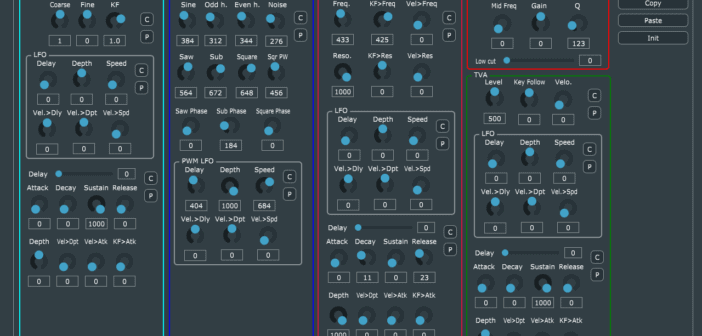Arthelion has introduced MOLOSS I, a freeware four-voice hybrid synthesizer in VST plugin format for digital audio workstations on Windows.
MOLOSS I (short for Multi Oscillator Linear Open Source Synthesizer) combines several synthesis methods to allow a very wide sound range. It features a four-voice architecture with subtractive and additive synthesis, frequency modulation and cross-modulation for each voice. Despite its complex sound engine, the instrument is lightweight and doesn’t consume a large number of CPU resources.
See also: Best FREE Synthesizer VST PluginsIn addition to the oscillator module, each voice features a resonant filter, a couple of LFO and ADSR modules, and a dedicated modulation panel. The main panel features a set of master volume controls for the four voices, along with the global LFO controls and a pair of built-in effects (chorus and reverb).
Unfortunately, the interface isn’t very user-friendly, especially considering the instrument’s complexity. Many of the parameters are marked with non-descriptive labels and its easy to get lost within MOLOSS I’s numerous controls. Hopefully, the interface is just a work in progress and the developer is planning to release a more polished-looking version of the plugin at a later date. The same can be said about the default soundbank since MOLOSS I doesn’t come with any presets at the moment. A built-in preset manager is included in the current release, though.
That said, MOLOSS I is a promising new synthesizer plugin. It is an open-source project under the GPL 3 license and chances are that further development is underway.
The instrument’s polyphony is 64 notes by default. Additionally, the plugin features two monophonic “solo” modes. A standalone version of the instrument is included in the download along with the VST plugin file for Windows.
More info: MOLOSS I (32-bit & 64-bit VST plugin format for Windows)



6 Comments
Drew Lake
onI had a mess around with this yesterday and it has great potential but like you stated with GUI I kept getting lost trying to find the most basic of functions… The only other gripe I noticed too is I wished it had more Filter options instead of just a standard LPF.
Tomislav Zlatic
onYes, very unpolished UI but lots of potential undeneath. No idea how I’d go about decluttering that interface, though. It’s not so much about improving the graphics as it about making the controls easier to find.
Hannes
onI think this UI is the default JUCE UI, or “look and feel” how they called it. Seems like there was not much effort in the design.
Arthelion
onTomislav, thank you for your detailed review.
It’s indeed the basic JUCE look’n feel as Hannes said, and i’ve done so far just the strict minimum work on it to have a total control on all the parameters. A lot is still to do on this topic. With some pratice it remains usable, though, and on the other hand the engine is already rather optimized. I’ve got several ideas to unclutter this and give it a better look, it’s just a matter of time that is lacking for now (any help is really welcome :)).
I developped it with the need of being able to generate sounds between D50, DX7, Juno…. in a single module, and it actually does the job. It goes well through the mix (even with loud drums and heavy guitars).
By the way, there are actually many factory sounds in the zip distribution, you can open them with the integrated file manager. I’ll complete them as I elaborate news. If you send cool stuff, i’ll add them to the library.
Thanks for your support !
Stan D. Art
onNeed check this myself but after just watching the demo vid with the presets. Sounds cold and pretty standard to me=
Alexander
onPresets are present, correct the description text, which says that they are absent